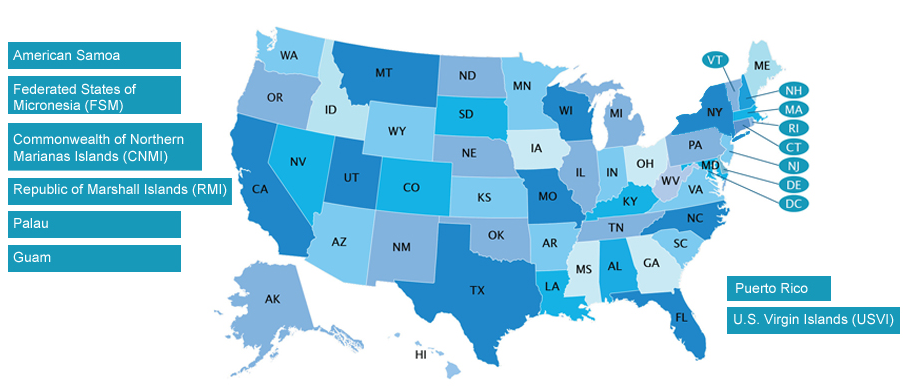Submitted by David Blumenthal on
 In honor of Career and Technical Education (CTE) Awareness Month, the College and Career Readiness and Success (CCRS) Center is highlighting new additions to our Interactive State Map. Each state profile now includes more information on CTE initiatives with a focus on the standards each state has adopted.
In honor of Career and Technical Education (CTE) Awareness Month, the College and Career Readiness and Success (CCRS) Center is highlighting new additions to our Interactive State Map. Each state profile now includes more information on CTE initiatives with a focus on the standards each state has adopted.
Today, we announced the addition of eight new territories to the map: American Samoa, the Commonwealth of the Northern Marianas Islands (CNMI), the Federated States of Micronesia (FSM), Guam, Palau, Puerto Rico, the Republic of the Marshall Islands (RMI), and the U.S. Virgin Islands (USVI). Visitors to the interactive map can now review, compare, and contrast college and career readiness policies and programs for all 50 states, D.C., and now the eight territories.
Visitors to the website can choose to navigate to an individual territory or compare information among other territories or states. Those interested in state- and territory-level college and career readiness programs can use the newly revised Interactive State Map as a quick reference guide. State education agencies can compare their own policies with those from other states by content area or region. Researchers can review information about college and career readiness initiatives throughout the United States and its territories. And program staff can review how policies have been implemented in different parts of the country.
The new section on CTE in each profile offers an overview of the state's or territory's policies on the following items:
- Secondary and postsecondary CTE standards
- The adoption authority for the standards
- Perkins IV five-year state plan
- Programs of study available in each state or territory
As of January 2015, 46 states and three territories have adopted statewide CTE standards at the secondary level, and 13 have adopted postsecondary standards.[1] Most states have adopted or modified the National Career Clusters Framework for programs of study. This framework provides a structure for states to develop programs of study within groupings of in-demand careers and industries.
The interactive state map also provides information on the Advanced Placement Incentive and similar programs; CTE standards and programs of study; dual enrollment and Early College High School; participation in national policy initiatives, such as the Next Generation Science Standards and Race to the Top; development and use of longitudinal data systems; and alignment between secondary and postsecondary requirements for high school graduation and college entrance, respectively.
Profiles for each state and territory were developed from a variety of sources including publicly available information from state education agency websites and the U.S. Department of Education. The information on CTE standards was adapted from The State of Career and Technical Education: An Analysis of State CTE Standards by the National Association of State Directors of Career Technical Education Consortium (NASDCTEc). This 2014 report compares existing state and territory CTE standards to those incorporated into the Common Career Technical Core and related policies.
Content for the eight new territories came from a variety of sources, including the U.S. Department of Education and territories’ own education agencies. Visit the map today to find out more!
David Blumenthal is a research associate and Caroline Martin is a research assistant with the College and Career Readiness and Success Center.
[1] The 13 states or territories have both secondary and postsecondary standards.

Add new comment